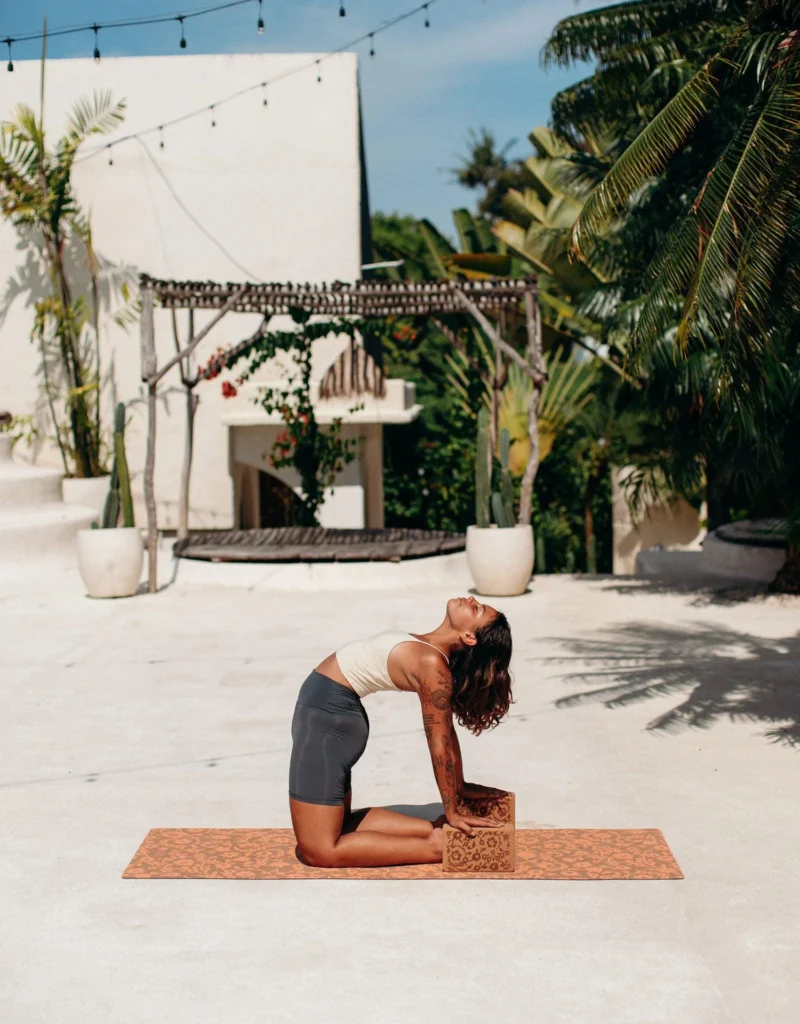This entry was posted on Jun 30, 2025 by Charlotte Bell.

A few weeks ago, I wrote a post on how to prepare your body for Camel Pose (Ustrasana). Camel Pose is a challenging backbend. It stretches the entire front body, especially the quadriceps, abdomen, chest and shoulders. In the post, I outlined a sequence you can practice in order to stretch and mobilize these vital areas of the pose. In today’s post, I’ll describe how you can practice Camel Pose with Yoga Blocks to make the pose more accessible and comfortable.
A common concern in practicing Camel Pose is that straining to reach your heels with your hands restricts breathing. Practicing Camel Pose with Yoga Blocks raises your hands and decreases the strain on your chest, which can help ease your breathing.
Not everyone’s spinal structure supports easy backbending. As you can see from the above photo, the lion’s share of the backbend occurs in the lumbar spine. (The thoracic spine is not really designed for more than minimal backbending.) Some people’s lumbar spinous processes are large and thick, meaning that they will “hit” each other much sooner than shorter, thinner spinous process do. This restricts range of motion in spinal extension.
In addition, some practitioners have a more pronounced thoracic kyphosis (convex curve). This also restricts range of motion in backbending. So even though the thoracic spine’s range of motion in backbending is limited, even a small amount of extension makes the pose easier, whereas a curvier thoracic spine will restrict movement. All this is to say that practicing Camel Pose with Yoga Blocks can make the pose accessible to almost everyone.
How to Practice Camel Pose with Yoga Blocks
You can practice Camel Pose with Yoga Blocks three ways. Yoga Blocks have three different height options: tall, medium and short. (The above photo shows blocks at their medium height.) Here’s how to practice Camel Pose with Yoga Blocks.
- Gather your props: a Yoga Mat and two Yoga Blocks. You may also place a folded Yoga Blanket under your knees for extra padding if you like. If you’re using a blanket, fold it so that it is narrower than your mat, and place it in the center of the mat.
- Come to a kneeling position on your mat and/or folded blanket.
- Place blocks at their highest level on the outsides of your feet. If you’re kneeling on a blanket, make sure your blocks are on your mat or on the floor rather than on your blanket to give them a stable base. (This applies to solid flooring such as wood or concrete. I wouldn’t recommend using blocks on plush carpeting.)
- Place your hands on your pelvic rim and press down, releasing your tailbone toward your knees.
- Lift your chest and lengthen your spine as you begin to bend backward, reaching for your blocks.
- Take a few breaths with the blocks at their highest height. Is your breathing free and unrestricted? If not, stay here for a few more breaths to see if it becomes easier.
- If your breathing is easy, feel free to turn the blocks on their sides, to medium height. Check in again with your breathing. If your breathing is free and easy, take a few breaths here. Then if you want, you can lower the blocks to their lowest level. Again, check your breathing.
- Free, unrestricted breathing is way more important than getting your hands to your heels or to the lowest height of your yoga block. So keep checking your breathing to make sure it feels relaxed.
- Take 5 to 8 deep breaths, wherever you are in the pose. Then return to kneeling and either sit on your heels or sit on one of your Yoga Blocks as your knees allow.
One More Suggestion
Yoga Blocks can certainly make Camel Pose more comfortable, but it’s equally important to make sure that we prepare the body to the fullest extent possible before we embark on Ustrasana. I highly recommend that you read the post I wrote a few weeks ago about how to prepare your body for Camel Pose, and how to cool down afterward to rebalance your body. Your breath—and a couple Yoga Blocks—can guide you into a Camel Pose that’s both exhilarating and relaxed.
About Charlotte Bell
Charlotte Bell discovered yoga in 1982 and began teaching in 1986. Charlotte is the author of Mindful Yoga, Mindful Life: A Guide for Everyday Practice and Yoga for Meditators, both published by Rodmell Press. Her third book is titled Hip-Healthy Asana: The Yoga Practitioner’s Guide to Protecting the Hips and Avoiding SI Joint Pain (Shambhala Publications). She writes a monthly column for CATALYST Magazine and serves as editor for Yoga U Online. Charlotte is a founding board member for GreenTREE Yoga, a non-profit that brings yoga to underserved populations. A lifelong musician, Charlotte plays oboe and English horn in the Salt Lake Symphony and folk sextet Red Rock Rondo, whose DVD won two Emmy awards.

